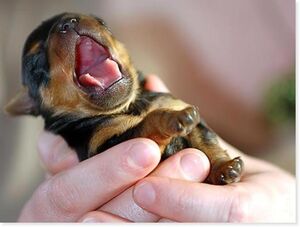Puppy Huffing
Puppy Huffing is the new, more intense alternative to Kitten Huffing taking the world by storm.
Huffing a puppy[edit]
Some puppies are immune to the common Kitten Huffing methods due to having long snouts at an early age. The cupped hands method must be modified (place your hands around the snout rather than the whole head) and the pipe method is not possible. However, they add the possibility of Puppy Snorting, which involves inhaling their chest hair. This is slightly less intense than normal huffing methods, but has no ill effects other than nasal irritation, and is preferred by first-time huffers who can't get their hands on a kitten.
Types of puppy[edit]
Since puppies come in a much wider range of shapes and sizes than kittens, huffers can choose the puppy that fits their skill level and lifestyle. As the size of the breed goes up, the difficulty and intensity of the huff generally increases along with the duration and intensity of the resulting high.
Chihuahuas[edit]
This is the breed experts recommend for beginners, especially those graduating from kitten huffing. Due to their small size, chihuahuas are easy to huff and leave the user high for a few minutes.
Shetland Sheepdog[edit]
Shetland Sheepdogs (or "Shelties") are slightly more intense than Chihuahuas, and are unique in that even adult Shelties can be huffed. Their huffability is based on size, not age, so be careful not to get the poorly bred 'Giant Sheltie".
Dachshunds[edit]
This breed is ideal for those who desire a longer high with minimal extra effort. The long, short, and narrow build of the dachshund enables the user to experience a high for as long as thirty minutes with relative ease.
Afghan Hounds[edit]
This stubborn breed is perfect for huffers looking to add a little spice to their huffing experience. The feisty nature of the Afghan hound translates to a short but very intense high.
Great Danes[edit]
Large breeds, such as great danes, are only recommended for well-trained and experienced huffers due to the strength required to successfully accomplish the huff. With that in mind, those who have huffed great danes and puppies of other large breeds frequently claim the day-long highs are worth the risk of bleeding, suffocation, hallucinations, social isolation, and mental illness.
Mixed breeds[edit]
Experienced huffers who know what they want from their puppy huffing sessions may choose a mutt to get the best of multiple worlds and otherwise fine tune their puppy huffing experience.
Benefits of puppy huffing[edit]
For the individual huffer, puppy huffing brings pleasure and excitement to life as well as great friendship.
On a larger scale, puppy huffing has been proposed by several animal welfare groups as a way to pare down the millions of strays roaming the streets of every major city in the world. One such group promotes puppy huffing with the following slogan: "A puppy huffed is a puppy off the street!"
That same group also warns that huffing stray puppies is only for the experienced and risk-tolerant huffer, not for the faint of heart.
Risks of Puppy Huffing[edit]
While the medical community has yet to acknowledge the medical benefits of puppy huffing, it has certainly documented the risks. Puppy huffers have suffered from migraine headaches, heart attacks, broken teeth, throat cancer, and traumatic brain injury. According to the puppy huffing fan community, these problems are usually caused by beginners trying to huff too large a puppy too early. All of this can be prevented by starting with the smallest breeds and slowly working one's way up the scale. Some fan clubs recommend avoiding large breeds altogether to reduce the risk of serious health problems associated with puppy huffing.
